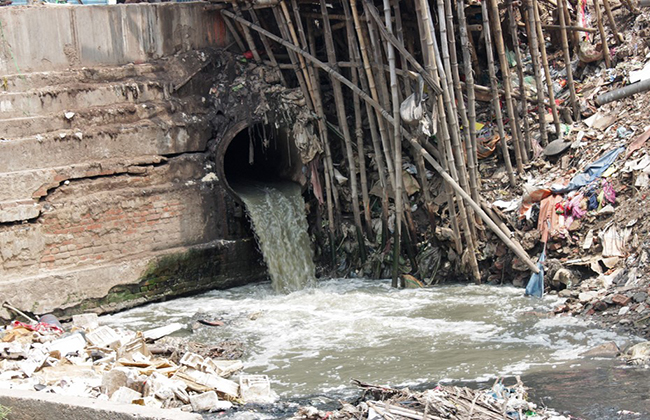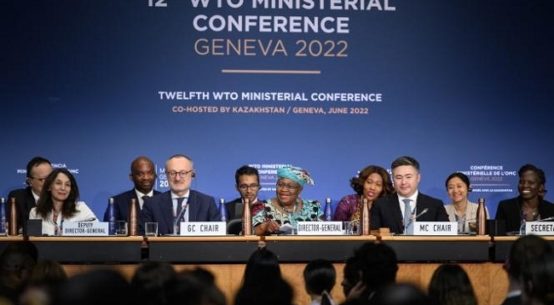
Md. Dulal Mia, 50, ferries passengers in his small boat from one end of the Buriganga River to the other. He has been living along the river for the last three decades.
“The stench from the pitch-black water is almost intolerable. Nearby factories and houses release their sewage into the river,” says Dulal.
Not just the Buriganga; most bodies of water in and around Dhaka have become toxic as a result of the city’s inefficient sewage system. The water not only carries toxic substances and harmful bacteria, but recent studies have found further presence of “emerging pollutants” such as microplastics and antibiotics.
All of this has resulted in a spike in waterborne diseases among the city’s inhabitants.
The city’s sewage treatment plants (STPs) have capacity to treat only 30% of the sewage produced daily, while the lack of coordination between two government agencies responsible for managing sewage and waste has exacerbated the situation.
Most residences’ sewage systems are connected to the city’s drains, which carry the wastewater through storm sewers to STPs. Many storm sewers are sealed or damaged, disrupting the flow of sewage, while there are also not enough STPs to treat all the sewage.
The treatment plants usually release the water into rivers after treatment. The city is supposed to have five separate treatment plants at the sewage release points in five rivers — Turag, Balu, Buriganga, Dhaleshwari and Shitalakshya. Not a single one of them, however, is functional.
“We have storm sewage lines in Dhaka because we don’t have a system of ground storage of sewage waste,” Shahriar Hossain, secretary general of Environment and Social Development Organization (ESDO), told Mongabay.
“But the storm sewage lines are also not functional. Most sewage is released into the water without being treated,” he added.
New research highlight presence of emerging pollutants
A recent study found an alarming presence of emerging pollutants (EPs) in surface water, which has become a new threat to the environment and health, as the existing sewage system is inefficient at treating industrial and household waste.
The study, published in the Journal of Hazardous Materials Advances this October, said an abundance of microplastics was found in water and sediments of Dhaka’s urban lakes and rivers. Nineteen sites (in five lakes and five rivers) were sampled for the study.
Another study also confirmed that EPs, which include antibiotics, microplastics, detergents, toothpastes, shampoos and lotions, are polluting the environment. The study was published in the Journal of the Bangladesh Chemical Society.
There is evidence of coliform, fecal coliform, E. coli and microplastics in Dhaka’s surface water as a result of sewage waste contamination. Such contamination cannot be purified even after boiling the water, experts say.
Shafi Mohammad Tareq, a corresponding author of the Chemical Society study and also a professor at Jahangirnagar University’s Department of Environmental Sciences, told Mongabay, “Dhaka city needs a huge quantity of STPs to treat the city’s sewage waste.”
The presence of antibiotics is a particular menace for city dwellers.
Antibiotics are used to neutralize harmful bacteria inside the human body, but antibiotics doses cannot be absorbed 100% by the human metabolic system. Thus, up to 40% of live antibiotics remain in sewage after leaving the human body.
These remaining antibiotics eventually get released into the environment, rivers and lakes.
“When live antibiotics, even in a limited amount, reach the environment, it helps the bacteria available in the environment to develop resistance. Therefore, we become vulnerable to drug resistance, meaning antibiotics become ineffective against bacteria-borne diseases,” said Tareq.
Pharmaceutical companies across the globe have been struggling to develop new antibiotics as existing antibiotics have become drug-resistant.
Meanwhile, microplastics exist in nanograms or micrograms in the sewage, which cannot be treated by conventional effluent treatment plants, or ETPs.
Bangladesh mostly imports ETPs from India and China and has found they are inefficient to treat microplastics, according to the researchers of the study.
Health hazard
Microplastics have a serious adverse effect on the environment and public health. The chemicals used in making plastic are toxic and can lead to cancer in the human body. There is evidence of microplastics in the food chain, including in sea and river fish, salt and sugar.
Excessive amounts of harmful microplastics have been found in the soil, water and animals in the Buriganga River.
In another study, researchers examined the soil, water, 11 species of fish, snails and crabs of the Buriganga River, and found the presence of microplastics. Riverbed sediment, water and fishes are affected by microplastics and metals. Sediments host most of the pollutants.
The study was published this October in the peer-reviewed journal Science of The Total Environment.
Emerging pollutants like microplastics, antibiotics, lotions, toothpastes, whitening detergents and shampoos, which are being released into the environment through water sources, also enter agricultural land. They enter food grains and eventually the human body, creating long-term health effects.
“All drinking water, including WASA [Water Supply and Sewerage Authority] water and bottled water of different companies, carry E. coli bacteria, which we find in the toilet,” ESDO secretary Hossain added.
Such bacteria cannot be treated using conventional methods, so they remain in the water and food chain. The growing number of waterborne stomach diseases among Dhaka city residents is an indication of that, Hossain pointed out.
Gastric medicines have recently become the top-selling medicine in Bangladesh over the last five years. Taka 34.18 billion ($331 million) in gastric medicines was sold last year, a 30% increase, according to a recent report by Bangabandhu Sheikh Mujib Medical University.
Lackluster authorities
The Dhaka city corporation is supposed to monitor and manage the storm sewage system while the Dhaka Water Supply and Sewerage Authority (WASA) is supposed to manage waste treatment for the city’s residential water supply.
But there is a serious gap between the two government agencies in ensuring service to city dwellers.
Dhaka North City Corporation (DNCC) chief executive Md. Selim Reza told Mongabay that an “embarrassing” situation prevails in sewage waste management in Dhaka, mainly due to the lack of cooperation among the government agencies.
“People who are responsible for managing it have shown negligence,” he said, admitting there were no waste treatment plants in most of the sewage points in Dhaka, while the rest were not functioning properly.
He suggested Dhaka residential building owners install treatment plants to treat household sewage waste to keep the environment safe.
The city authority said it had taken up a number of fresh programs to reconstruct the faulty sewage system, apart from efforts to stop sewage contamination of rivers and other water sources.
The city authority has also warned building owners of Dhaka’s upscale residential areas like Gulshan, Banani and Baridhara that they will seal their sewage line if any building is found releasing sewage water into city lakes.
Gholam Mostofa, chairman of the Dhaka WASA board, also admitted to the coordination gap between the two government agencies. However, he told Mongabay the city corporation is leading the city’s sewage waste management system.
“It is crucial there is coordination among government agencies to have a sound sewage management and ensure a healthier environment in Dhaka,” he said, adding the situation would have been better if the ongoing projects of WASA gathered momentum in implementation.
DNCC Mayor Md. Atiqul Islam recently said that in Dhaka city, authorities had tried to culture fishes in city lakes, and even in posh areas, but failed completely. The lakes have become breeding grounds for mosquitoes instead.
The city authority has already written to the capital development authority, RAJUK, to impose requirements for installation of treatment plants in residential buildings in order to treat household sewage waste before it is released into the environment.
Experts say the city sewage system needs to be improved and redesigned, zone-wise, one after another, and not in unison or concurrently.
(This article was republished from Mongabay on Creative Commons License)
S.M. Najmus Sakib is a Dhaka-based journalist


